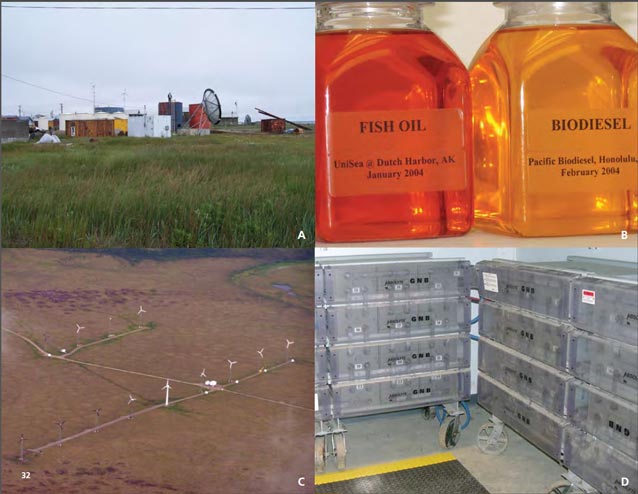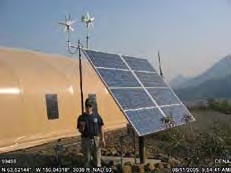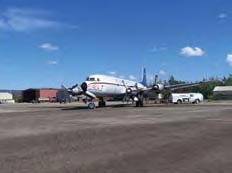
(A) NPS photograph by R. Winfree(B) Alaska Energy Authority photograph(C) NPS photograph by R. Winfree(D) NPS photograph
Development and infrastructure are spread over a wide variety of landscapes in Alaska, often in a very discontinuous manner, and energy use and transporta-tion are very much in that mode. Under-standing the challenges of alternative and sustainable energy in Alaska’s national parks requires an understanding of how energy is produced, utilized, and trans-ported in Alaska. While we often say that “we are different” in Alaska, the energy infrastructure is much different than in states outside of Alaska – a situation that gives us our greatest challenge and our greatest advantages in finding, developing, and utilizing alternative and sustainable energy in our national parks. Alaska’s largest energy uses are for electrical power generation, heat, and transportation, such as on and off-road vehicles, planes, and snow machines (Szymoniak 2008, USDOT).
Development, supply and distribu-tion of energy in Alaska
The development, supply, and distribution of energy in Alaska, with the notable exception of facilities along the limited road system, are almost entirely a series of independent electricity, fuel storage, and distribution systems. There are no electrical connections to grids outside of Alaska, and the grids that do exist in Alaska are not connected to each other. There are a series of small electrical grid systems serving parts of Southeast Alaska and one larger grid that follows the road system from Fairbanks to Homer (www.seconference.org/inter.html). The only natural gas grid of any significance centers around Anchorage in Southcentral Alaska, and uses mostly locally produced gas from wells in Cook Inlet and the Kenai Peninsula. The other natural gas grid serves only Fairbanks and currently uses natural gas that is produced and trucked from Southcentral Alaska. There is no significant natural gas grid in Southeast Alaska. The rest of the state depends on local power generation, fuel storage, and distribution. Over 200 villages and towns produce their own power and heat, mostly from diesel fuel for which a large infrastructure of storage tanks has been set up in the villages (see Figure 1A) (Szymoniak 2008). The magnitude of this is such that the diesel fuel used for the pro-duction of electricity and heat in Alaska at least equals all of the diesel fuel used in all of the road vehicles in the state (ISER, US-DOT). In the rural areas of the state, where most of the national parks are located, only 14% is used for transportation and the rest is almost evenly split between heating (45%) and electrical production (41%) (ISER). There is typically some propane use in the villages, but it is usually used for cooking and comes in small tanks rather than in combined tank systems.
The national parks of Alaska are situated throughout the state, but only four connect to one of the grids. Sitka National Historic Park is the only one with “commercial” power available to the entire park, although it is available in most of Klondike National Historic Park. The headquarters at Denali National Park and Preserve and Kenai Fjords National Park are on the electrical grid, but major infrastructure and uses are off of the grid. Some park areas, including some headquarter areas located outside of the park, are connected to the electrical systems of the villages and towns which produce their own power. In other areas, however, the National Park Service may be the sole provider of electricity. The parks or parts of parks that exist on a grid typically have lower costs per unit of energy (e.g., Kwh, BTU), but the source of the power needs to be evaluated as to how sustainable it may be. The park areas on village electrical systems typi-cally have higher unit costs (AEA 2008), but the source of the power is more easily evaluated. The parks that produce their own power typically have the highest energy costs, but also have the opportunity to change or modify their energy source and usage by themselves.

NPS
The lack of permanent infrastruc-ture also manifests itself in the large costs of energy storage, usually in the form of diesel storage tanks. Most off-road communities have to store large amounts of energy because the transportation of the energy is weather-limited to very short times of the year. That is particularly true with the villages above 60 degrees north latitude where sea ice prevents barges from making deliveries during the winter (Figure 3). Some villages have to fly in all of their fuel. A few have some access to ice roads for the transportation of fuel, but their need for storage is similar, since they cannot be resupplied by trucks during the summer. Again, our parks face these same issues.
What to do about increasing the alternative and sustainable energy systems, as outlined above, is heavily dependent upon the circumstances of how power, heat, and fuel storage is accomplished locally. The solution, then, has to be largely on the local level and can take many forms. There is no single solution or “silver bullet” that is going to solve every problem. There can be an overall strategy of education and demonstration projects, as well as solutions that make economic and ecological sense, but they have to be tempered with the local facts and reality. We also know that we have the enviable position of being able to work with issues in different ways and different partners to try and come up with these transferable solutions. This is the challenge that we face.
The Alaska Region’s focus on reducing our carbon footprint will be successful only if we tackle the specific energy issues that affect each park and determine where we can make the most progress in reducing energy and showing that these efforts, often in technology, can be transferable to other parks and communities in Alaska. We have started to do this in some areas and are building upon that knowledge to take it further. As in all new endeavors, there are calculated risks of success and setbacks that must be taken as a learning experience. We have had both in recent years in Alaska, but are still planning for the future.
Increasing use of alternative and sustainable energy may not end our use of fossil fuels right away, but instead working towards reduction in the short term, and elimination in the long run. Many alternative energy sources do not function reliably 24 hours a day or in all months of the year (e.g., solar and wind) but are available some of the time (Figure 1D). There are also renewable alternatives that can reduce the amount of energy used (biodiesel). We have taken on three long-term efforts, along with a number of related projects, to try and reduce and eliminate use of fossil fuels.

R. Winfree
Hybrid Power Systems
The Alaska Region replaced many of our diesel generators with hybrid systems which consist of different combinations of solar, hydro, and wind power, often combined with propane generators. This has resulted in reduced generator run times, reduced energy usage, reduced air and noise pollution, and reduced maintenance service intervals (Figure 2). Some areas that ran generators 24 hours a day are down to two to six hours a day by using batteries to store energy (Denali National Park and Preserve Facility Manager, personal communication.), often in conjunction with an alternative energy source. The initial application of this was at the old Eielson Visitor Center in Denali in the late 1990s, with a hybrid diesel and solar system. Since that time, hybrid systems have been installed in Denali at Wonder Lake (propane and solar) and at the new Eielson Visitor Center, where a replacement system generates hydroelectrical power using the same water as the domestic water system, supplemented with a propane generator. A battery hybrid system was installed at Exit Glacier in Kenai Fjords National Park in conjunc-tion with a propane generator that has reduced the run time by about 70%. Installation of a solar and battery hybrid system is in progress at Wrangell-St. Elias National Park and Preserve in the Kennecott area, which will provide quiet power to that National Historic Landmark. A similar installation is planned for Brooks Camp at Katmai National Park and Preserve, which will also replace much of the diesel heating fuel with propane. There is a solar diesel hybrid system working at the Coal Creek area of Yukon-Charley Rivers National Preserve, and plans to replace diesels with hybrids at Lake Clark and Glacier Bay. A wind turbine is also being installed at Anaktuvuk Pass in Gates of the Arctic National Park and Preserve that will feed power into the village power grid.
Fuel Cell
A partnership between the Na-tional Park Service, the Alaska Energy Authority, the Arctic Developmental and Testing Laboratory at the University of Alaska Fairbanks, and the Denali Commission installed and enabled the operations of a 5 Kilowatt Solid Oxide Fuel Cell at the Exit Glacier area of Kenai Fjords National Park. This fuel cell is the only one in the country that runs without benefit of online monitoring and powers actual electrical loads rather than just contributing to the electrical grid. This is an off-grid installation that utilizes hydrogen reformed from propane to operate. The fuel cell is situated right in the Nature Center at Exit Gla-cier to demonstrate hydrogen technology potential to the public in an actual operating condition. It has provided electric power to the Exit Glacier area for five summers. The heat from fuel cell operations also heats the Nature Center, demonstrating the cogeneration abilities of this technology. This project has been a success in showing people what a fuel cell looks like, and how it can quietly produce both electricity and heat. We have modified and adjusted the operating parameters of the fuel cell each year and contributed information about a fuel cell operating in actual field conditions. However, we do not feel that hydrogen fuel cell technology is yet reliable enough for placement in remote areas (Energy Alternatives).

NPS
Biodiesel
The National Park Service has partnered with the Alaska Energy Authority and the Arctic Developmental and Testing Laboratory at the University of Alaska Fairbanks, to demonstrate the use of biodiesel produced from a local byproduct of a major industry in Alaska, fish oil (Figure 1B). The biodiesel was made from fish oil from the pollock fishery near the Alaska Peninsula and used in vehicles and a diesel generator at the Toklat area of Denali National Park and Preserve in place of diesel fuel. The generator ran much of the summer of 2006 on 100% fish oil biodiesel and some vehicles ran on a 30% blend of fish oil biodiesel and diesel fuel. The generator ran successfully on 100% biodiesel fuel at the first part of the summer, but it soon became apparent that the fish oil feed stock was degrading fairly rapidly and was starting to coat some of the parts of the generator with a hard film that caused parts of the generator to fail. We have since been working with the other partners to stabilize the fuel, so that we can continue its use. There are millions of gallons of fish oil potentially available and a biodiesel fuel market could reduce the dumping of fish parts into the oceans, improve the economics of producing fish oil and other fisheries byproducts, and reduce the cost of diesel fuel in the remote parts of Alaska. The ultimate use of this fuel would be at a educed percentage, replacing 5%-20% of the diesel fuel in the parks and villages near the production of the fish oil. This is a long-term project that is transferable to the remote parts of the state as it uses local products. Ideally, it could be used for all of the energy in a place like Brooks Camp, where spill potential is reduced or where energy is produced in villages adjacent to the park.
Wind and Hydropower
There are considerable wind resources available in Alaska, and we have begun to look at using those in an efficient and aesthetic manner, such as with the village of Anaktuvuk and small turbines in Denali, as well as utilizing village power produced by wind turbines in Kotzebue (Figure 1C). The small hydro project at the Eielson Visitor Center that combines the use of potable water and energy production without dams or impairing a stream underscores the innovative thinking that must occur to match the area with the need. Wrangell-St. Elias has been studying a stream at Kennecott so that a historic hydro system can be rebuilt that will help power the area in conjunction with fire protection. This project also has the potential to produce hydrogen by electrolyzing water from the excess energy produced by the hydro system. This could be utilized to run vehicles and potentially make the Kennecott area free of hydrocarbon energy for electricity, heat, and vehicles. Klondike Gold Rush National Historic Park is utilizing some electric vehicles for their maintenance needs. This is a particularly effective use of energy at Klondike since the electrical power in Skagway comes from a renewable hydro system that has been in place for about 100 years. Other areas are looking at electric vehicles that can be powered up at night or low use times when power is wasted because the grid cannot go down. This will take some agreements with the power company to provide interruptible power so that the vehicles will only charge when that power would otherwise be wasted. The region is also looking at run of the river and tidal projects that can be done without affecting the environment – either in partnerships with villages or as demonstration projects.
There are many possibilities for alternative and sustainable energy sources in Alaska, but it will continue to take a concerted effort on the part of the Region and the parks to fit each individual situation. As can be seen, we have started down that path. We need to continue, realizing that not everything will work; however, success can only occur by trying.
References
Alaska Energy Authority (AEA). 2008.
Alaska Energy Plan. State of Alaska.
Energy Alternatives.
Unpublished data. Palmer, Alaska.
Szymoniak, Nick. 2008.
Direct Fuel Use in Rural Alaska. Insti-tute of Social and Economic Research (ISER). University of Alaska, Anchorage.
U.S. Department of Transportation,
Research and Innovative Technology Administration, Federal Highway Administration.
Part of a series of articles titled Alaska Park Science- Volume 8 Issue 1: Connections to Natural and Cultural Resource Studies in Alaska's National Parks.
Previous: Fred Dean Interview
Next: The Colors of the Aurora
Last updated: August 10, 2016
